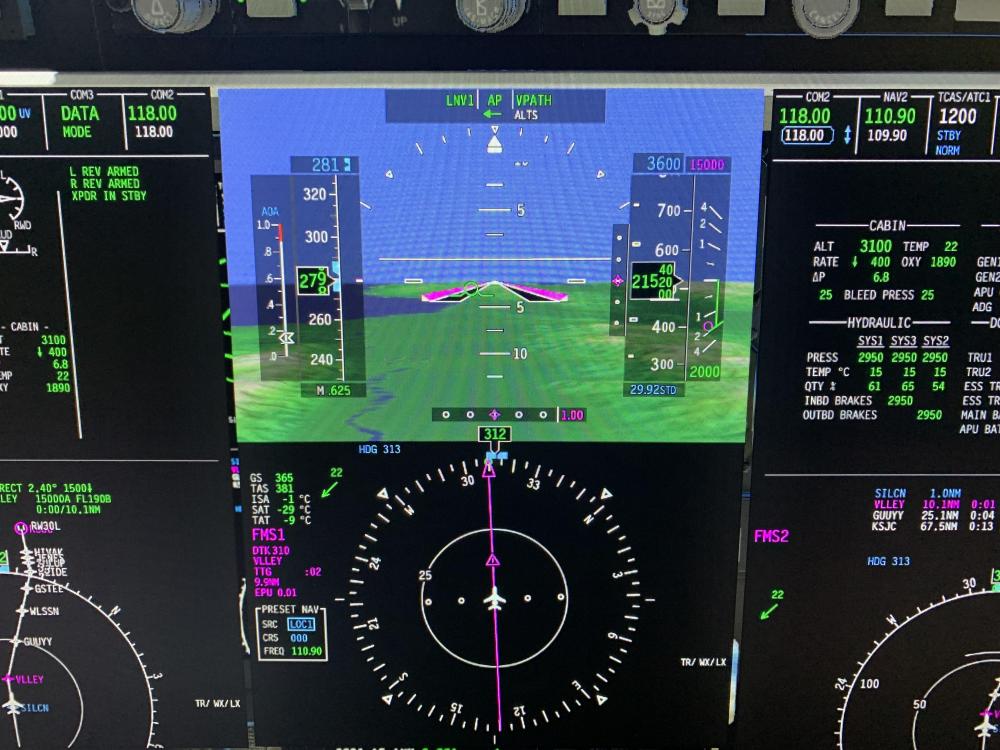Leaderboard
Popular Content
Showing content with the highest reputation on 01/01/2024 in all areas
-
The Challenger can be hard work on the approach and landing, but when it all comes together it's very rewarding. All the beta testers had difficulty learning how to land, it's all part of the fun. On approach be aware that unlike aircraft like the 737, the pitch response to power is reversed, that means a power increase will see the aircraft pitch down for a moment. This can lead to an oscillation developing, so be sure to fly the pitch attitude accurately. If you find you're wobbling up and down, aim to make smooth power changes, and remember the HUD flight path vector is useful tool, but can get you into trouble too. A useful check is 0.6 on the AoA index on approach. If it's higher than that, you're too slow. Remember Vref +5, and check your weights on the approach ref page. For the landing flare, lift the nose to to arrest the rate of descent, starting at just below 40 ft. Make a smooth power reduction and fly the aircraft onto the runway. The pitch attitude in the flare is around 3 degrees, but look at the end of the runway, not the HUD! You'll have plenty of time for butter later, so for now put the aircraft down positively in the touchdown zone. If you go butter hunting, you'll only find little bounces - ask me how I know! Once you've landed, extend the flight spoilers (the ground spoilers are automatic, but the flight spoilers need to be raised by pulling the lever), use the reversers and you're down. And stay away from that HLIS button, it'll trick you into making your landings worse!1 point
-
1 point
-
From the details you've provided, it appears that the crash is not directly related to the activation process of the aircraft but rather a failure to read a file. However, a point to note is that your activation plugin is not loading, which is due to the fact that you're using a Mac M1 Max and Rosetta is not enabled. Rosetta is necessary for running the CL650 at this time. To enable Rosetta on your Mac: Locate X-Plane in Finder: Go to your Applications folder and find the X-Plane application. Get Info: Right-click (or Control-click) on the X-Plane application and select 'Get Info' from the context menu. Enable Rosetta: In the 'Get Info' window, you'll find an option to 'Open using Rosetta'. Check this box. Close and Restart: Close the 'Get Info' window and restart X-Plane. With Rosetta enabled, X-Plane should run the necessary plugins correctly, including the activation plugin for the CL650. This should allow you to proceed with the activation and use of the CL650. Let's start there.1 point
-
The issue might be with the new plugin, that splits Gizmo64 into two different plugins.1 point
-
If has Gizmo, I assume it is X-Avaition product. To amend functionality, where is possible, I will only go with c/c++/rust solution. Not because any issues using Gizmo/SASL/FWL in one acf, but because of performance. Having too many interpreters running at the same time, won't be nice.1 point
-
Is it possible to provide screenshots or a video from prior to and during the descent, please? That'd help us figure out what's happening. Just a clarifying note on some differences between the 737 and Challenger: 1. VNAV isn't a descent mode unto itself, rather it's a modifier on the other modes, e.g. FLC, V/S, PATH, and PTCH. Enabling VNAV will allow the FMS to control altitude preselection to meet flight plan restrictions, and also speeds if separately enabled. 2. The descent path calculated by the FMS is not an idle power descent as is often used in airliners. The Challenger will fly a geometric path, based on the default descent angle set, a per-leg override, or what's required to meet a restriction.1 point
-
1 point
-
Version 1.0.0
998 downloads
Hotstart Challenger 650 | R&J Air (Laminar Blue)| N1219L Tested for X-Plane 12 only. Normals may look weird on 11!!! Enhanced texturing including - New cockpit windshield - Improved aircraft fuselage normals - Improved riveting - Improved engine exhaust and intake - Tuned glossiness - Tuned cabin windows Please respect my work. Copying/Modification is not permitted. Happy flying!1 point -
Version 1.0.0
332 downloads
Hotstart Challenger 650 | TAG Aviation (Malta) | 9H-VVP Tested for X-Plane 12 only. Normals may look weird on 11!!! Enhanced texturing including - New cockpit windshield - Improved aircraft fuselage normals - Improved riveting - Improved engine exhaust and intake - Tuned glossiness - Tuned cabin windows Please respect my work. Copying/Modification is not permitted. Happy flying!1 point -
No problem at all. I do understand the complexity - the Challenger is a very rare sim aircraft that does almost everything like the real thing. The resources the development team have had are exceptional. Newbie questions are totally fine, and that's exactly the point in the forum. Any frustration from forum participants is usually down to when posters phrase questions that read like "Boeing does X so Hot Start Challenger is wrong." It's a different sort of system, but one by one we'll make sure the sim community are confident ProLine 21 Advanced pilots ;-) Not being able to do an idle descent is unusual coming from an airliner background, but when you understand the system is designed to be just as useful without autothrust, and the descent angle mode is probably more pilot-friendly anyway it starts to make a lot of sense.1 point
-
thanks Graeme, i really love this plane and the simulation level it brings to xplane, finding more information isn't easy since every company has it own Sop's. So you (team) were experiencing a lot of questions from users and 99% of the time is not a figner point to the quality of the CL650 but simply a newbie question. And to be transparent I like to say that dev team should not answer like "the challenger is doing exactly like this" or other answers similar, but taking some time to answer is well appreciated. Appreciated like your YT videos since they're a masterpiece of explanation. (still waiting the last felis 747 one :P) thanks1 point
-
@kecm80It's just an airplane - it flies on pitch/power like everything else. That chart is only giving you some approximate pitch/power datums to help you fly the aircraft. You can descend using VFLC if you want - that will give you an idle descent and will obey the constraints, but managing the profile will be your responsibility.1 point
-
I guess this is just a consequence of the ATS being somewhat independent from the FMS due to its “aftermarket” origins on the type.1 point
-
No, it’s not like an Airbus or Boeing. It targets a fixed FPA, respecting constraints otherwise, and that’s it.1 point
-
VNAV button remains lit when valid. All vertical modes become VNAV modes with exception of VPATH which auto-arms at ToD. FLC = VFLC (follows VNAV profile in either climb or descent) ALTS = VALTV (respects crossing restrictions regardless of set altitude) VPATH = auto-armed at ToD and will commence descent if altitude selector is lower that present altitude (double chord sound at path intercept) Ensure the option (PERF x 2) is set for "ENABLE ADVISORY VNAV". It will draw the vertical diamond on the PFD when the vertical path is near. Also ensure to "RESUME VNAV SPEED" (PERF x 2) to get it to follow the VNAV speed schedule, otherwise the selected speed takes precedence.1 point
-
VALT will transfer to VPATH when you hit the ToD. If you want to descend now, FLC or VS. Remember VNav is a modifier, not a discrete mode. When you intercept the target path, in any vnav modified mode (VALT, VFLC, VVS, VPTCH) you’ll go to VPATH and follow the programmed descent.1 point











